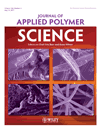Structure and mechanical properties of nanodispersed fibrous silicate-reinforced ethylene–propylene–diene monomer nanocomposites
Abstract
In this study, ethylene–propylene–diene monomer (EPDM)/fibrillar silicate (FS) nanocomposites were successfully prepared by mechanically blending EPDM with FS, which was modified by silane coupling agent KH570 containing methacryloxy group. The effects of silane content and modified FS on the dispersion of FS and mechanical properties of the composites were investigated. The impact of water in FS on mechanical properties of the composites was also evaluated. The results showed that modified FS could be dissociated into nanofibers dispersing evenly in the EPDM matrix by increasing substantially the loading of silane through the mechanical blending. The optimum loading level of silane coupling agent was up to 24 phr/100 phr FS. Silane KH570 could improve the dispersion of FS and strengthen nanofibers–rubber interfacial adhesion even at the loading of as high as 50 phr FS, making FS to exhibit excellent reinforcement to EPDM. Too much FS could not be completely dissociated into nanofibers, slowing down further improvement. The EPDM/FS composites exhibited the similar stress–strain behavior and obvious mechanical anisotropy with short microfiber-reinforced rubber composites. With the increase in silane coupling agent and modified FS, the number of nanofibers increased because of the exfoliation of FS microparticles; thus, the mechanical behaviors would become more obvious. It was suggested that the free water in FS should be removed before mechanically blending EPDM with FS because it obviously affected the tensile properties of the composites. Regardless of whether FS was dried or modified, the EPDM/FS composites changed little in tensile strength after soaked in hot water. © 2010 Wiley Periodicals, Inc. J Appl Polym Sci, 2011




